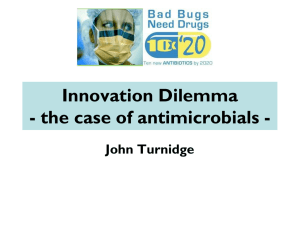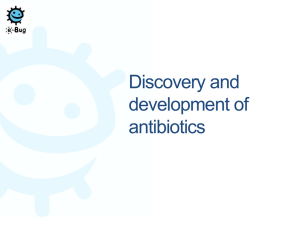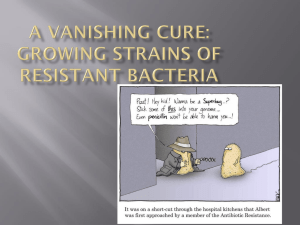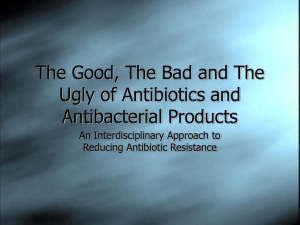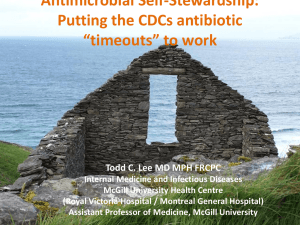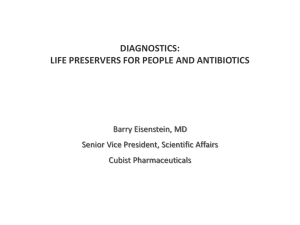115-Hassali-_a
advertisement
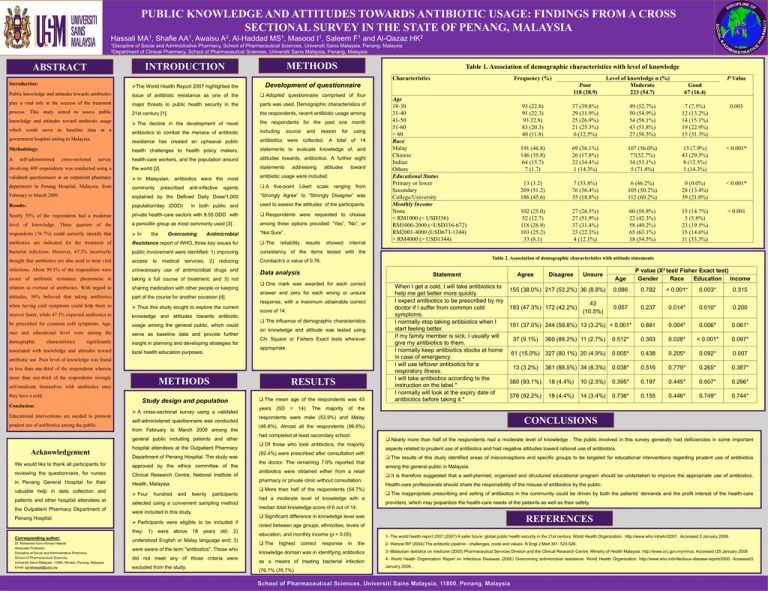
PUBLIC KNOWLEDGE AND ATTITUDES TOWARDS ANTIBIOTIC USAGE: FINDINGS FROM A CROSS SECTIONAL SURVEY IN THE STATE OF PENANG, MALAYSIA Hassali MA1, Shafie AA1, Awaisu A2, Al-Haddad MS1, Masood I1, Saleem F1 and Al-Qazaz HK2 1Discipline of Social and Administrative Pharmacy, School of Pharmaceutical Sciences, Universiti Sains Malaysia, Penang, Malaysia 2Department of Clinical Pharmacy, School of Pharmaceutical Sciences, Universiti Sains Malaysia, Penang, Malaysia METHODS INTRODUCTION ABSTRACT Table 1. Association of demographic characteristics with level of knowledge Characteristics Introduction: The World Health Report 2007 highlighted the Development of questionnaire Public knowledge and attitudes towards antibiotics issue of antibiotic resistance as one of the Adopted questionnaire comprised of four play a vital role in the success of the treatment major threats to public health security in the parts was used. Demographic characteristics of process. This study aimed to assess public 21st century [1]. the respondents, recent antibiotic usage among knowledge and attitudes toward antibiotic usage The decline in the development of novel the respondents for the past one month antibiotics to combat the menace of antibiotic including resistance has created an upheaval public antibiotics were collected. A total of 14 health challenges to health policy makers, statements to evaluate knowledge of, and health-care workers, and the population around attitudes towards, antibiotics. A further eight involving 408 respondents was conducted using a the world [2]. statements validated questionnaire at an outpatient pharmacy In Malaysian, antibiotics were the most antibiotic usage were included. department in Penang Hospital, Malaysia, from commonly A five-point February to March 2009. explained by the Defined Daily Dose/1,000 “Strongly Agree” to “Strongly Disagree” was Results: population/day (DDD) used to assess the attitudes of the participants. which could serve as baseline data at a government hospital setting in Malaysia. Methodology: A self-administered cross-sectional survey prescribed anti-infective agents in both public and source and reason addressing Likert for using attitudes scale toward ranging from Nearly 55% of the respondents had a moderate private health-care sectors with 9.55 DDD with Respondents were requested to choose level of knowledge. Three quarters of the a penicillin group as most commonly used [3] . among three options provided: “Yes”, “No”, or respondents (76.7%) could correctly identify that In “Not Sure”. antibiotics are indicated for the treatment of Resistance report of WHO, three key issues for The bacterial infections. However, 67.2% incorrectly public involvement were identified: 1) improving consistency of the items tested with the the Overcoming Antimicrobial thought that antibiotics are also used to treat viral access infections. About 59.1% of the respondents were unnecessary use of antimicrobial drugs and aware of antibiotic resistance phenomena in taking a full course of treatment; and 3) not relation to overuse of antibiotics. With regard to sharing medication with other people or keeping attitudes, 38% believed that taking antibiotics when having cold symptoms could help them to recover faster, while 47.3% expected antibiotics to be prescribed for common cold symptoms. Age, race and educational level were among the demographic characteristics significantly associated with knowledge and attitudes toward to medical services; 2) reducing reliability results showed internal Thus this study sought to explore the current knowledge and attitudes towards antibiotic usage among the general public, which could serve as baseline data and provide further insight in planning and developing strategies for Data analysis Statement One mark was awarded for each correct response, with a maximum obtainable correct score of 14. The influence of demographic characteristics on knowledge and attitude was tested using Chi Square or Fishers Exact tests wherever antibiotic use. Poor level of knowledge was found in less than one-third of the respondents whereas more than one-third of the respondents wrongly METHODS self-medicate themselves with antibiotics once RESULTS they have a cold. Conclusion: Educational interventions are needed to promote prudent use of antibiotics among the public. The mean age of the respondents was 43 Study design and population A cross-sectional survey using a validated self-administered questionnaire was conducted from February to March 2009 among the general public including patients and other Acknowledgement We would like to thank all participants for reviewing the questionnaire, for nurses in Penang General Hospital for their valuable help in data collection and patients and other hospital attendees at the Outpatient Pharmacy Department of Penang Hospital. hospital attendees at the Outpatient Pharmacy Department of Penang Hospital. The study was approved by the ethics committee of the Clinical Research Centre, National Institute of Four Dr. Mohamed Azmi Ahmad Hassali Associate Professor, Discipline of Social and Administrative Pharmacy School of Pharmaceutical Sciences Universiti Sains Malaysia, 11800, Minden, Penang, Malaysia Email: azmihassali@usm.my and twenty participants were included in this study. were = 14). The majority of above 18 years old; 2) understood English or Malay language and; 3) were aware of the term "antibiotics". Those who did not meet any of those criteria were excluded from the study. When I get a cold, I will take antibiotics to help me get better more quickly. I expect antibiotics to be prescribed by my doctor if I suffer from common cold symptoms. I normally stop taking antibiotics when I start feeling better. If my family member is sick, I usually will give my antibiotics to them. I normally keep antibiotics stocks at home in case of emergency. I will use leftover antibiotics for a respiratory illness. I will take antibiotics according to the instruction on the label.* I normally will look at the expiry date of antibiotics before taking it.* P Value Good 67 (16.4) 93 (22.8) 91 (22.3) 93 22.8) 83 (20.3) 48 (11.8) 37 (39.8%) 29 (31.9%) 25 (26.9%) 21 (25.3%) 6 (12.5%) 49 (52.7%) 50 (54.9%) 54 (58.1%) 43 (51.8%) 27 (56.3%) 7 (7.5%) 12 (13.2%) 14 (15.1%) 19 (22.9%) 15 (31.3%) 0.003 191 (46.8) 146 (35.8) 64 (15.7) 7 (1.7) 69 (36.1%) 26 (17.8%) 22 (34.4%) 1 (14.3%) 107 (56.0%) 77(52.7%) 34 (53.1%) 5 (71.4%) 15 (7.9%) 43 (29.5%) 8 (12.5%) 1 (14.3%) < 0.001* 13 (3.2) 209 (51.2) 186 (45.6) 7 (53.8%) 76 (36.4%) 35 (18.8%) 6 (46.2%) 105 (50.2%) 112 (60.2%) 0 (0.0%) 28 (13.4%) 39 (21.0%) < 0.001* 102 (25.0) 52 (12.7) 118 (28.9) 103 (25.2) 33 (8.1) 27 (26.5%) 27 (51.9%) 37 (31.4%) 23 (22.3%) 4 (12.1%) 60 (58.8%) 22 (42.3%) 58 (49.2%) 65 (63.1%) 18 (54.5%) 15 (14.7%) 3 (5.8%) 23 (19.5%) 15 (14.6%) 11 (33.3%) < 0.001 Agree Disagree Unsure Age P value (X2 test/ Fisher Exact test) Gender Race Education Income 155 (38.0%) 217 (53.2%) 36 (8.8%) 0.086 0.782 < 0.001* 0.003* 0.315 43 193 (47.3%) 172 (42.2%) (10.5%) 0.057 0.237 0.014* 0.010* 0.200 0.881 0.004* 0.006* 0.061* 151 (37.0%) 244 (59.8%) 13 (3.2%) < 0.001* 37 (9.1%) 360 (88.2%) 11 (2.7%) 0.512* 0.303 0.028* < 0.001* 0.097* 61 (15.0%) 327 (80.1%) 20 (4.9%) 0.005* 0.438 0.205* 0.092* 0.007 13 (3.2%) 0.038* 0.516 0.779* 0.265* 0.387* 361 (88.5%) 34 (8.3%) 380 (93.1%) 18 (4.4%) 10 (2.5%) 0.395* 0.197 0.445* 0.507* 0.296* 376 (92.2%) 18 (4.4%) 14 (3.4%) 0.736* 0.155 0.446* 0.749* 0.744* the respondents were male (53.9%) and Malay CONCLUSIONS (46.8%). Almost all the respondents (96.8%) had completed at least secondary school. Of those who took antibiotics, the majority (92.4%) were prescribed after consultation with the doctor. The remaining 7.6% reported that antibiotics were obtained either from a retail had a moderate level of knowledge with a Nearly more than half of the respondents had a moderate level of knowledge . The public involved in this survey generally had deficiencies in some important aspects related to prudent use of antibiotics and had negative attitudes toward rational use of antibiotics. The results of this study identified areas of misconceptions and specific groups to be targeted for educational interventions regarding prudent use of antibiotics among the general public in Malaysia. It is therefore suggested that a well-planned, organized and structured educational program should be undertaken to improve the appropriate use of antibiotics. Health-care professionals should share the responsibility of the misuse of antibiotics by the public. The inappropriate prescribing and selling of antibiotics in the community could be driven by both the patients’ demands and the profit interest of the health-care providers, which may jeopardize the health-care needs of the patients as well as their safety. median total knowledge score of 6 out of 14. Significant difference in knowledge level was Participants were eligible to be included if 1) (SD More than half of the respondents (54.7%) selected using a convenient sampling method they: Corresponding author: hundred years pharmacy or private clinic without consultation. Health, Malaysia. Age 18-30 31-40 41-50 51-60 > 60 Race Malay Chinese Indian Others Educational Status Primary or lower Secondary College/University Monthly Income None < RM1000 (< USD336) RM1000-2000 (<USD336-672) RM2001-4000 (USD673-1344) > RM4000 (> USD1344) Cronbach’s α value of 0.76. appropriate. local health education purposes. Poor 118 (28.9) Level of knowledge n (%) Moderate 223 (54.7) Table 2. Association of demographic characteristics with attitude statements answer and zero for each wrong or unsure part of the course for another occasion [4]. Frequency (%) REFERENCES noted between age groups, ethnicities, levels of education, and monthly income (p < 0.05). The highest correct response in 1- The world health report 2007 (2007) A safer future: global public health security in the 21st century. World Health Organization. http://www.who.int/whr/2007. Accessed 3 January 2009. the knowledge domain was in identifying antibiotics as a means of treating bacterial infection (76.7% (76.7%) 2- Wenzel RP (2004) The antibiotic pipeline - challenges, costs and values. N Engl J Med 351: 523-526. 3- Malaysian statistics on medicine (2005) Pharmaceutical Services Division and the Clinical Research Centre. Ministry of Health Malaysia. http://www.crc.gov.my/nmus. Accessed (25 January 2009. 4- World Health Organization Report on Infectious Diseases (2000) Overcoming antimicrobial resistance. World Health Organization. http://www.who.int/infectious-disease-report/2000. Accessed3 January 2009..


